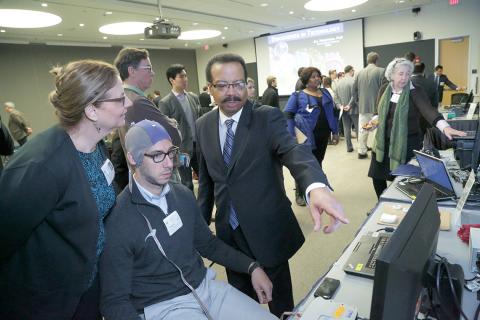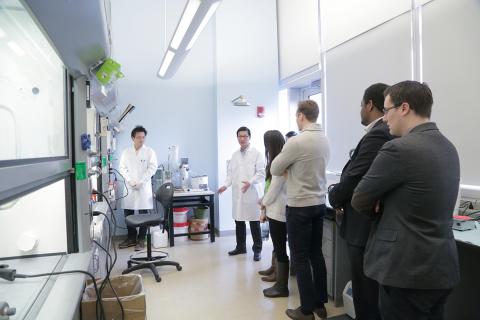NIBIB Showcases Biomedical Tech for Congressional Staff

A hand-held ultrasound needle-guidance device, cuffless blood pressure monitor and brain-wave sensor were among the technologies exhibited for about 30 congressional staff members who visited the National Institute of Biomedical Imaging and Bioengineering recently. The NIBIB Discoveries in Technology Expo drew staff from congressional offices of members from California, Colorado, Florida, Indiana, Massachusetts, Mississippi, North Carolina, Nebraska, New Jersey, New York, Ohio, Pennsylvania, Texas and South Carolina.
“We provided a powerful, first-hand look at some remarkable biomedical technologies,” said NIBIB director Dr. Roderic Pettigrew. “Each technology has been developed with NIBIB support and has the potential to enhance health care delivery or catalyze biomedical research. The technology expo gives our visitors the opportunity to become as excited as we are about these new biomedical devices and approaches.”
The American Institute for Medical and Biological Engineering, which plays an advocacy role for the fields of medicine and biological engineering, arranged the congressional field trip, held at the Porter Neuroscience Research Center.
The event featured hands-on demonstrations of tech advances being made with NIBIB support. In addition, there was a tour of NIBIB’s Laboratory of Molecular Imaging and Nanomedicine (LOMIN).
To give patients control over their own medical images, the Radiological Society of North America (RSNA) Image Share platform allows seamless access to and sharing of images such as MRIs, CT scans and X-rays. The online system, as demonstrated by an RSNA representative with the Icahn School of Medicine at Mount Sinai, is designed to give patients easy image access regardless of the location of patient or provider.
Recipients of an NIBIB-funded Small Business Innovative Research grant demonstrated a handheld ultrasound device that anesthesiologists can use while administering epidural anesthesia to the spine. The device helps locate the precise spot for needle insertion and is particularly helpful for women in childbirth and patients for whom obesity makes finding the precise epidural target especially difficult. Rivanna Medical, based in Charlottesville, Va., developed the device, which received Food and Drug Administration clearance in July 2015 and now is being marketed to hospitals.

The traditional tool for measuring blood pressure has remained largely unchanged for decades. A team from Michigan State University demonstrated cuffless blood pressure measurement systems to non-invasively measure blood pressure, ideally in the home. These devices could make blood pressure measurement as easy as stepping onto a scale and will therefore help improve diagnosis and management of hypertension.
A New York-based research team demonstrated a cap that can capture brain-wave signals of the wearer and use them to operate a computer. The system is designed to help people with paralysis complete everyday tasks independently. A number of people with severe disabilities already are using the system in their homes. The research team is based at the New York State department of health; the National Center for Adaptive Neurotechnologies, Wadsworth Center; and Stratton VA Medical Center.
No visit to NIH is complete without a laboratory tour. LOMIN opened its doors to demonstrate positron emission tomography (PET) radiochemistry and analytical chemistry approaches to improve health care. The lab develops new imaging nanoprobes for PET and other imaging modalities. The probes are designed to improve early diagnosis of disease, monitor therapeutic response and guide drug discovery and development.
NIBIB’s Office of Science Policy and Communications, which coordinated the event with AIMBE organizers, also presented a demonstration. They previewed a mobile app now in development called Understanding Medical Imaging Scans. The app uses images and videos to provide concise answers that many patients may have about medical scans and will serve as a resource to explain the kinds of imaging tests a patient or family member might encounter during disease diagnosis or treatment. The app will soon be beta-tested before becoming available in waiting rooms of doctors and hospitals. The app will be kept updated as biomedical imaging technologies, like the technologies demonstrated at the expo, are continually innovated and introduced.
